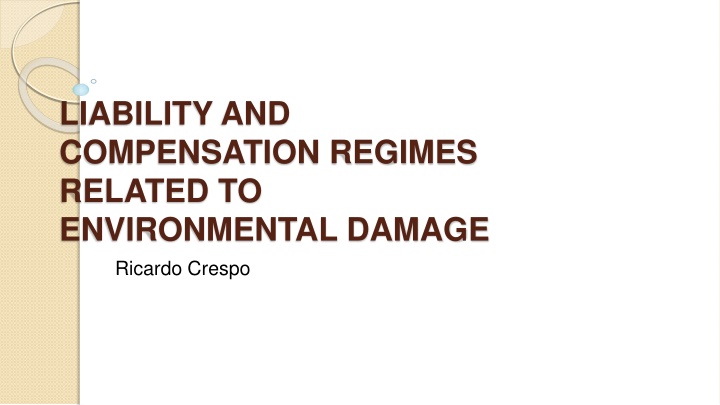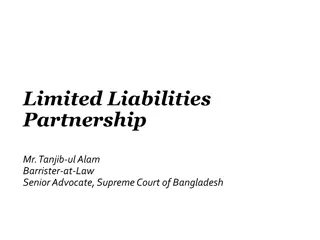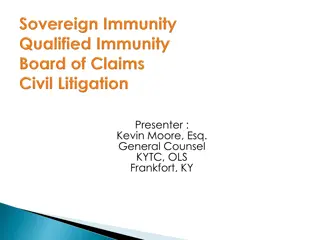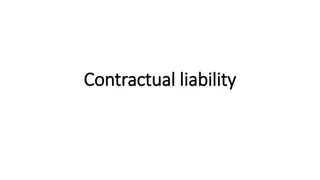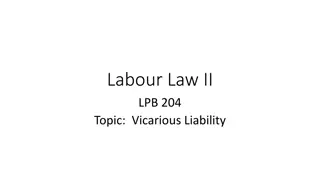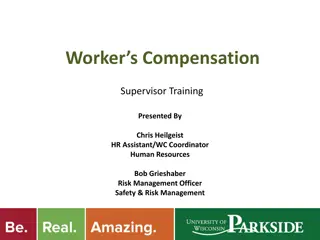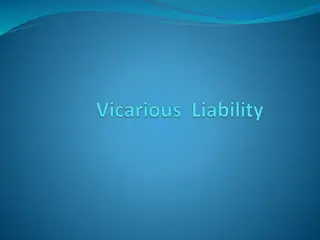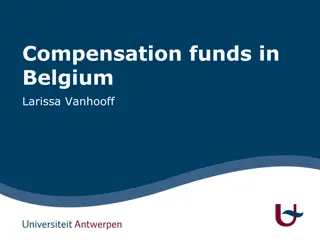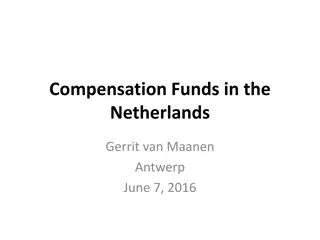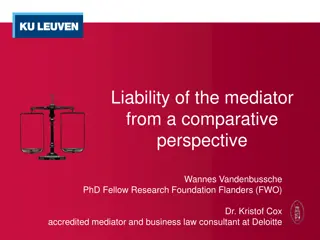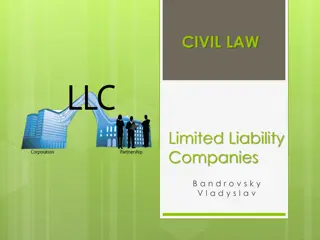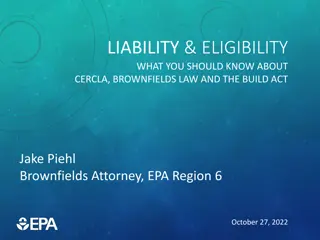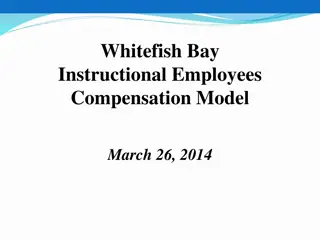Environmental Liability and Compensation Regimes: A Comprehensive Overview
Numerous environmental damages have occurred globally, leading to the need for liability and compensation regimes. This includes incidents like the Bhopal gas leak and Chernobyl nuclear accident. Concepts of tort law guide responsibility and compensation in cases of environmental harm, addressing issues such as land contamination and loss of biodiversity. Legal liability plays a crucial role in holding polluters accountable and ensuring repair or compensation for damages incurred.
Download Presentation

Please find below an Image/Link to download the presentation.
The content on the website is provided AS IS for your information and personal use only. It may not be sold, licensed, or shared on other websites without obtaining consent from the author.If you encounter any issues during the download, it is possible that the publisher has removed the file from their server.
You are allowed to download the files provided on this website for personal or commercial use, subject to the condition that they are used lawfully. All files are the property of their respective owners.
The content on the website is provided AS IS for your information and personal use only. It may not be sold, licensed, or shared on other websites without obtaining consent from the author.
E N D
Presentation Transcript
LIABILITY AND COMPENSATION REGIMES RELATED TO ENVIRONMENTAL DAMAGE Ricardo Crespo
Contents 1. General Backround 2. State Responsability 3. Sate Responsability and State Liability 4. Liability in international conventions 5. Civil Liability Regimes 6. Conclusions
General Backround Numerous severe damage to the environment that have affected the territory of countries all over the world. cases of Global commons are at risk.
1984 disaster, Bhopal gas leak 1986 Chernobyl nuclear power plant accident.
1986 Basel chemical spill into the Rhine Cyanide spill in the year 2000 from the Baia Mare mine in northwestern Romania. Marine oils pill incidents that have caused massive damage to the coasts of a number of countries.
Common examples include: Land contamination as a consequence of industrial accidents. Improper handling and disposal of waste; Water contamination as a result of various causes including discharge of untreated industrial effluents; Loss of biodiversity due to a wide variety of impacts including habitat loss and introduction of alien species.
Tort Law In general, concepts of liability and compensation stem from the principles of tort law in which a wrongful act causing injury permits the injured party to obtain compensation, usually in the form of money damages, through a private civil action against the person who caused the injury.
Questions Who should be held responsible for environmental harm? Who should pay for the costs involved in pollution clean-up and restoration of the damaged environment? What should be the standards for acceptable cleanups?
Legal liability is one way of forcing major polluters to repair the damage that they have caused, to pay for those repairs or to compensate someone for the damages if the damage cannot be repaired. Liability is a necessary to ensure that persons responsible for non-compliance environmental damage face the prospect of having to pay for restoration of the affected environment or compensating for the damage caused. resulting in
Types of Liability Civil liability operates on the level of national law, and creates a relationship between the person liable and the person injured by conduct for which he/she is held responsible. State responsibility, operates on the plane of public international law. It creates a relationship not between two or more individuals but between two or more states. The state, rather than a private individual, must provide a remedy for damage that occurs as a consequence of a breach of an international legal obligation established by treaty or rule of customary international law. State liability : has been developed chiefly by the United Nations International Law Commission ( ILC ), usually refers to the responsibility that a state faces for harm occurring as a consequence of a lawful activity, independently of whether there was any violation of an international norm.
Polluter Pays Principle (PPP) Liability implementing the Polluter Pays Principle ( PPP ). can be seen as a mechanism for The PPP was originally adopted by the Organization for Economic Cooperation ( OECD ) in 1972, contemplates the internalization of pollution-control costs. and Development
1992 Rio Declaration (Principle 16) National authorities should endeavour to promote the internalization of environmental costs and the use of economic instruments, taking into account the approach that the polluter should, in principle, bear the cost of pollution, with due regard to the public interest and without distorting international trade and investment.
STATE RESPONSIBILITY AND THE ENVIRONMENT The law of state responsibility is customary international law, developed by state judgments. practice and international Enforcement of public international law is rather limited because states participate reciprocal obligations, customary binding on the states, as it is evidence of generally accepted state practice and opinion iuris accepted as law. on voluntary international basis and law is
The concept of state responsibility only covers the case of breach of the states own obligations owed to another state or states. These obligations extend to the duty to ensure that activities undertaken by private parties do not cause harm to the territory of other states, as indicated by the Trail Smelter Arbitration, but do not include the responsibility of the private parties themselves. The latter is the object of civil liability regimes, which are designed to allow private individuals or organizations causing transboundary environmental harm to be held responsible for such damage.
The concept of state responsibility makes an obligation for states to act in conformity with the international agreements or customary law. Since the concept of state responsibility is applicable to the field of environment, the breaches of treaty or customary international law allow the injured state to lodge claim against injuring (violating) state whether by way of diplomatic action or by way of recourse to international mechanism where such are in place with regard to the subject matter at issue.
Most important principles of environmental protection are imposed by customary international law. One of those principles is the principle of state sovereignty over its territory and natural resources, which is a fundamental and the most important principle of international law in general.
Throughout the history states could use their own natural resources in the way they want regardless of the impact to the territory of another state. It is clear that this principle is no longer absolute . The limitation of territorial sovereignty is the obligation of states, not to act as to injure the rights of other states. State sovereignity also neighbourliness as well responsibility for causing the environmental damage in case that damage occurs. the as principle the principle of good state of
Principles of Good Environmental Governance derived from the Rio Conference Intergenerational Equity Sustainable Use Precaution Polluter pays Good neighbourliness Equity and fairness
Principles of Customary International Environmental Law ( Ius Cogens) Decision of the ICJ December 2015, Case between Costa Rica and Nicaragua: 4 main principles of International Environmental Law: 1. Due Diligence ( Part XII Law of the Sea. Environmental protection of the marine environment) 2. Prevention: ( Part XII Law of the Sea) 3. Cooperation : Notification and Consultation. 4. Prior Environmental Impact Assessment: Pulp Mills Case- Argentina vs. Uruguay 2010. Prevention and Due Diligence should be reflected with Cooperation and EIA.
Potential Principles of Customary International Environmental Law 1 . Precautionary Principle or Approach ( Principle 15 Rio Declaration). Additional manifestation of due diligence in environmental matters. 2. Public participation: ( Principle 10 Rio Declaration) 3. Principle of contemporeignity in the application of environmental norms. Treaties whether they refer to environmental issues or not , have to be interpreted in the light of existing environmental norms at the time of the application of the treaty. (Opinion of Judge Weeramantry in the Gab ikovo Nagymaros Project case 1997)
Classical principles of international law Two potentially contradictory notions Principle of territorial integrity recognizes the right of states to be free of interference from others Principle of territorial sovereignty recognizes the freedom of states to do as they like within their own territory.
Principle 21 of the Declaration adopted by the 1972 Stockholm Conference on the Human Environment States have, in accordance with the Charter of the United Nations and the principles of international law, the sovereign right to exploit their own resources pursuant to their own environmental policies, and the responsibility to ensure that activities within their jurisdiction or control do not cause damage to the environment of other States or of areas beyond the limits of national jurisdiction.
1992 Rio Declaration (Principle 2) States have, in accordance with the Charter of the United Nations and the principles of international law, the sovereign right resources pursuant to their own environmental and developmental policies, and the responsibility to ensure that activities within their jurisdiction or control do not cause damage to the environment of other states or of areas beyond the limits of national jurisdiction. to exploit their own
Principle was repeated by Principle 2 in Declaration on Environment and Development, adopted by the 1992 Conference held in Rio de Janeiro. Two most important soft-law instruments that have dealt with state responsibility for transboundary harm.
Principle 22 of the Stockholm Declaration provides that states are to ...cooperate to develop further the international law regarding liability and compensation for the victims of pollution and other environmental damage caused by activities within the jurisdiction or control of such States to areas beyond their jurisdiction.
Principle 13 of the Rio Declaration called on States to develop national law regarding liability and compensation for victims of pollution and other environmental damage (Principle 13) States shall also cooperate in an expeditious and more determined manner to develop further international law regarding liability and compensation for adverse effects of environmental damage caused by activities within their jurisdiction or control to areas beyond their jurisdiction.
Those principles are now included in various other binding and non-binding international instruments. They can be found in the relevant provisions of Article 194 (2) of the Convention on Law of the Sea (1982) and the Convention on Biological Diversity in Article 3.
The decision in the Trail Smelter arbitration is one of the most cited decisions by courts and tribunals in the field of state responsibility and the environment. The dispute was between United States and Canada because of the air pollution coming from the Canadian factory and causing the damage to crops in the United States.
Trail Smelter arbitration: The tribunal decided: that under the principles of international law, as well as the law of the United States, no state has the right to use or permit the use of its territory in such manner as to cause injury by fumes in or to the territory of another or the properties of persons therein, when the case is of serious consequence and the injury is established by clear and convincing evidence
This ban of causing harm to other state has been repeated in some other cases. In the Corfu Channel case in 1949. In this case United Kingdom suffered loss of human lives and damage to their vessels because the explosions of mines in Albania s territorial sea. The International Court of Justice stressed that it was Albania s obligation to notify and warn about those mines. Court held Albania responsible, set the compensation and declared that obligation of each state is not to allow knowingly its territory to be used for acts contrary to the rights of other states.
In the Lac Lanoux case, the dispute was between Spain and France about using the lake by France for generating electricity. It was needed to redirect part of the water to another river. Spain claimed that it would affect the interest of Spanish users of river. The tribunal decided there was a principle which prohibits the upstream state from alerting the waters of a river in such a fashion as seriously to prejudice the downstream state.
In the advisory opinion to UN General Assembly on the Legality of the Threat or Use of Nuclear Weapons the International Court of Justice stated that: The existence of the general obligation of states to ensure that activities within their jurisdiction and control respect the environment of other states or of areas beyond national control is now part of corpus of international law relating to the environment.
The ICJ also recognized in its Advisory Opinion on the Legality of the Threat or Use of Nuclear Weapons and in the Gabcikovo Case that: the existence of the general obligation of states to ensure that activities within their jurisdiction and control respect the environment of other states or of areas beyond national control is now part of the corpus of international law relating to the environment.
WeeramantryIn the Separate Gab ikovo Nagymaros Project case (1997) concerning the controversy between Hungary and Slovaquia on the construction of a dam on the Danube River: opinion of Vice-President We have entered an era of international law in which international law subserves not only the interests of individual States, but looks beyond them and their parochial concerns to the greater interests of humanity and planetary welfare. In addressing such problems, which transcend the individual rights and obligations of the litigating states, International environmental law will need to proceed beyond weighing rights and obligations within a closed compartment of individual State self interest, unrelated to the global concerns of humanity as a whole
Gabikovo Nagymaros Project case Separate opinion ofVice-PresidentWeeramantry: States that both the right to development and the right to environmental protection are principles currently forming part of the corpus of international law. They could operate in collision with each other unless there was a principle of international law which indicated how they should be reconciled. That principle is the principle of sustainable development which, according to this opinion, is more than a more concept, but is itself a recognized principle of contemporary international law.
Gabikovo Nagymaros Project case Separate Weeramantry: The Court, as representing the main forms of civilization, needs to draw upon the wisdom of all cultures, especially in regard to areas of international law which are presently in a developmental phase. Among the principles that can be so derived from these cultures are the principles of trusteeship intergenerational rights, protection of flora and fauna, respect for land, maximization of the use of natural resources while preserving their regenerative capacity, and the principle that development and environmental protection should go hand in hand. opinion of Vice-President of earth resources,
Conditions for state responsibility. Existence of the international obligation or duty between two states. An act that violates that obligation Loss or damage that resulted from an unlawful act. It is always crucial to identify the international obligation which has been breached. The real problem of this concept is that state responsibility does not provide any duty for compensation for damage resulted from activities that are not prohibited by international law.
Three main steps to raise a claim for damages under international law: 1.Identifying the damaging activity attributable to a state 2. Proving the causal link between act and the damage. 3. Determining either a violation of international law or a violation of a duty of care (due diligence).
Difference between State responsibility and State liability Two different legal concepts. State responsibility asserts that a state that violates an international obligation has to repair harm caused to another state. According to Kiss and Shelton the Trail Smelter case is the basis for the discussion on responsibility and liability environmental law but it left open the question of whether a state executing due diligence would be liable if transfrontier harm results despite the State's best efforts.
In the Trail Smelter case the tribunal did not clarify whether the state is liable only for intentional, reckless or negligent behaviour (fault based conduct) or it should strict liability be applied. Therefore, in the international environmental law it is necessary to distinguish arises upon breach of an international obligation and liability for injurious consequences of lawful activities. responsibility, which
State responsibility represents the consequence of, and sanction against, non-performance by states of their international obligations. (Brian D. Smith, State Responsibility and the Marine Environment, (Oxford University Press, 1988) p. 6 ). Objective theory of state responsibility: Just a violation of international law is relevant for the existence of state responsibility, regardless of the fault of the state. The ground for state responsibility depends on the content of an international obligation.
Fault responsibility theory: The supporters of the fault (culpa) theory took the Corfu Channel case as an example to justify their point of view. In this case the Court declared that a state which knows that a minefield has been located in its territorial waters would be obliged to notify states of its existence. However, the court did not mention fault (culpa) explicitly as a relevant condition for state responsibility, but supporters of the fault theory claimed that this was a clear proof that fault ( culpa) is a relevant element for the state responsibility.
Obligations which require no element of fault are those obligations entailing strict responsibility ,responsibility for failure to achieve a required or to prevent a prohibited result without consideration of intent or diligence. Kiss and Shelton note that the legal consequences of environmental harm cover both state responsibility for violation of international law and liability for harm caused by activities allowed by a state. The latter is strict or absolute liability.
States have historically showed great reluctance to initiate proceedings even where environmental damage is very severe. The decision not to invoke the responsibility of the Soviet Union regarding the Chernobyl disaster is an example of that reluctance. After the explosion in the nuclear reactor, the radioactive cloud crossed the air above Sweden, Germany, Austria, Switzerland, Italy and the ex Yugoslavia. States accepted only to cooperate, but no other obligation was imposed.
The Chernobyl disaster has shown that states are afraid of possible liability of their own acts in the future. As the states refused to accept liability for transboundary harm, it shifted to civil liability and transposed the liability to the 'operator' or person in control of a hazardous activity.
The difference between state responsibility and state liability is that liability is based on the creation of risk . The reasoning behind this claiming is that the state creating risk and benefiting from the risk shall also incur the consequences in case harmful injury occurs even for lawful acts.
Why should states be strictly liable for activities carried out, not by themselves but by private person on their territory. The private persons who economically benefit from those activities should carry liability in a form of civil liability. Only in case of 'partial or total default the state should have subsidiary liability.
In case of damage resulting from hazardous activities, state responsibility will be entailed only when rules on international law establish obligatory standards of safety to a state on whose territory the activities are carried out and the state has failed to impose or to control. Due diligence means that the states are required to adopt legislative and administrative controls applicable to public and private conduct, with the objective to effectively protect other states and the global environment.
Due diligence When transboundary damage, the state is required to take all necessary measures to prevent it. By definition, due diligence is an obligation of conduct, not an obligation of result. Due diligence is related to the principle of exclusive competence of a state on its own territory. If the activity which may have transboundary harm is performed by an individual on its territory, the state on whose territory the activity is performed must make sure to take measures for protection and control in order to prevent the harmful effects. the activity involves a risk of significant
State liability is defined as liability of state under public international law and civil liability means the liability of a natural or legal person under the domestic legislation including the legislation established to implement the provisions of international treaty obligations.
